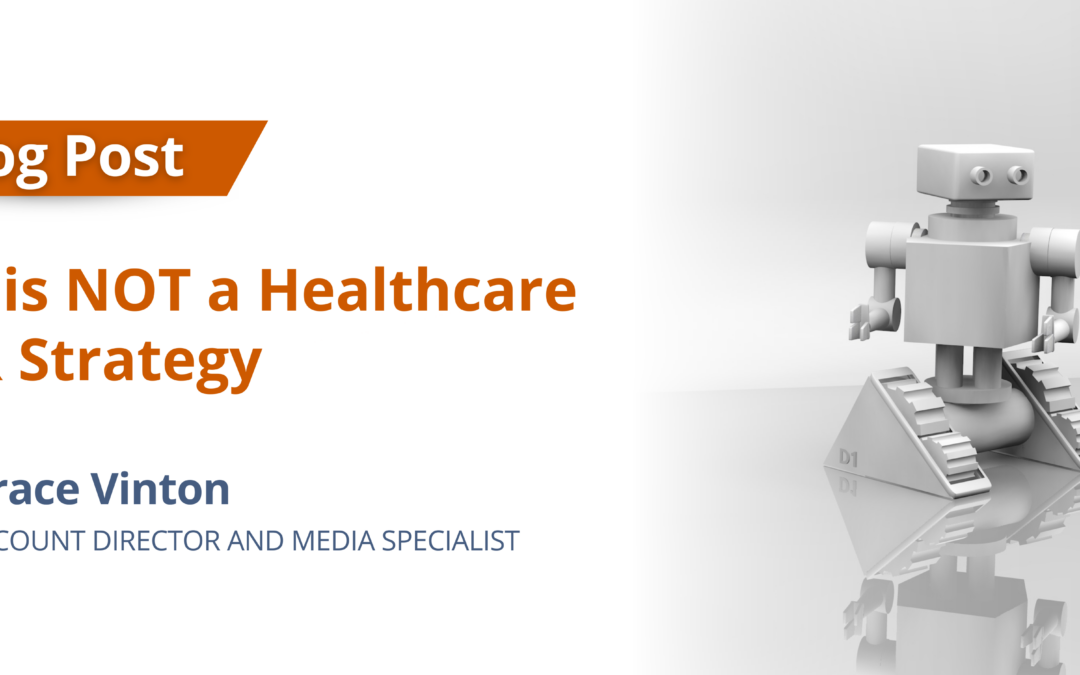
AI is NOT a Healthcare PR Strategy
What does our very own Grace Vinton say about AI?
“AI is not a healthcare PR strategy.”
But Grace also shares where she believes AI can fit in.
Check out what she has to say in this VLOG!

What does our very own Grace Vinton say about AI?
“AI is not a healthcare PR strategy.”
But Grace also shares where she believes AI can fit in.
Check out what she has to say in this VLOG!

Anyone who has spent any time in healthcare can tell you that there is never any shortage of companies touting how their products are, “revolutionary” or “next gen.” We’ve all heard it: “This solution will transform healthcare into a Garden of Eden! Lower costs! Happier patients! Over-the-moon clinicians!”
Standing out in a crowded marketplace is always difficult, especially when you’re the one singing your own praises. That’s where strategic and thoughtful media interviews enter the picture.
Media interviews offer the opportunity to build credibility by leveraging a third-party’s brand, generate leads for sales teams, and deliver a story that resonates with target audiences.
However, industry thought leaders (yes, you!) most often approach media interviews as if they are merely question-and-answer exercises. Great media interviews are much more than that. They are relationship-building opportunities that enable executives to truly build relationships with journalists while educating the industry.
The most appealing stories in healthcare involve a mix of data and human impact. The detail and specificity required to tell these stories to reporters are unlikely to simply pop into executives’ minds on the fly. That’s why media interview preparation is essential.
The ABCs and the 3 Ps
While there are many subtleties and nuances involved in preparing for interviews, a good place to begin is what I call the ABCs and the 3 Ps. These are handy mnemonic devices to help executives get in the right mindset for interviews.
To craft those key messages, begin by thinking about how to incorporate the 3 Ps:
While it’s wonderful to share inspiring and touching stories of how your product or technology led to “patients whose lives were transformed” or “doctors who overcame burnout to rediscover their love of practicing medicine,” it’s important to understand that, in reality, those stories aren’t always readily available, and massive change or sensationalism doesn’t always lead to the type of incremental progress required in the world of healthcare.
The most impactful stories can be how a new solution saves a few clicks in electronic health records or how it helps clinicians save time at the bedside. Those are still interesting stories that are worth telling; they just require a little strategic thought and planning to make them more accessible to reporters and understandable to the public.
To begin crafting a compelling story to share during media interviews, start with the ABCs and the 3 Ps – but above all, be generous with the wisdom you share. The industry will be better for it!

Sometimes you say what everybody is thinking. And when that happens, the reaction can be tangible and immediate.
I was a member of a panel at the recent HIMSS conference and was talking about misinformation. At one point I observed, “Healthcare has a B2B problem, but it’s not business to business; it’s boring to boring.”
All of a sudden everybody started snapping their fingers. I hadn’t seen this reaction before and asked whether people were trying to get my attention. It was confusing! Someone said, “No, you’re on fire.” It seems they agreed with what I said and wanted me to keep going, but didn’t want to interrupt me by clapping. Hence the snapping.
That interesting cultural moment wasn’t about me, but about an awareness clearly shared by most healthcare PR and marketing professionals: Healthcare technology companies and their buyers are mired in boredom. Boring problems. Boring solutions. Boring conversations.
The sad reality is that both healthcare technology companies and their customers – providers, payers, and third parties – are afraid to express a strong opinion or point of view for fear of losing business opportunities.
We’re all sick of boring. Still, I get it: Clients don’t want to confuse or concern a potential customer by saying something audacious or expressing bold thoughts. Healthcare tech companies want to focus their message on what their product does and the problems it can solve for customers. No point in straying from focused thought leadership.
While I understand the strategic impulse toward boring, companies that want to stand out from their competitors need to get more creative with their messaging without confusing buyers or pigeonholing the company as providing a specific solution to a specific problem. Otherwise they may continue to float anonymously in a sea of boring.
Below are some tips for healthcare marketing and PR pros to help their clients and organizations inject some personality and perspective into their messaging.
Connect on a human level
This is healthcare. By definition, it’s about people; serving people and connecting with people. One of the best ways to connect with people is to tell a compelling story. People love hearing stories and are drawn in by a narrative arc that features a journey with highs and lows, challenges and triumphs, and lessons learned.
Great storytellers are relatable and interesting and thus able to connect with an audience. Their stories create a whole world that provides context, rather than running an audience through a tedious list of specific product features and use cases. To sell your product, tell your story.
Go multimedia
Storytelling is about more than the written word. Audio and video are powerful mediums for healthcare technology companies to tell their stories. Not only do some audience members absorb information more efficiently through multimedia, allowing them to see and hear the people behind a healthcare technology company leverages that human connection we all seek.
Even a great infographic or data visualization provides a multimedia tool that can help you articulate a story and emphasize key points. Audience members have diverse learning styles and digital literacy skills; adding a multimedia element to your message will broaden its reach.
Initiate and be part of a conversation
Rather than just relentlessly pumping out marketing collateral, healthcare technology companies should strive to be thought leaders in their sector. Having a voice in an ongoing conversation establishes credibility and puts a human face on the company. Healthcare is a mission-based career, so advocating for your mission and what you believe in resonates with a like-minded audience. People don’t follow companies; they follow other people with great ideas.
Bylined articles published on respected healthcare websites are a great vehicle for demonstrating sector expertise and thought leadership. When potential buyers think you really “get” their challenges, they’ll remember you and your company.
Social media also provides an excellent platform for conversations and idea exchange. LinkedIn probably is the best for healthcare professionals, though many also actively use X. Healthcare technology leaders also can connect with their community through organizations like HIMSS or CHIME.
Finally, some healthcare technology companies have been successful in using podcasts to tell their stories. Some are even launching their own podcasts to provide another venue for interacting with an audience.
Speak the truth (with humor)
The great comedians find humor in everyday life. They also find humor in the truth. If healthcare technology leaders speak the truth to their audiences and find a way to inject humor into the message, they will stand out from the crowd. Humor that is informed by a deep understanding of the industry and the challenges of a particular sector can be memorable. If your humorous truths support your value proposition, all the better.
Conclusion
Healthcare technology companies that hide in the herd and play it safe get ignored. To rise above the boring noise and get your message across, you need to inject your marketing and PR initiatives with a strong storyline framework that employs passion, humanity, humor, and a distinctive voice. Sincerity sells because it’s real and conveys a compelling message: We’re all in this together.

The HIMSS Global Conference and Exhibition is a well-established healthcare innovation industry conference that Amendola has attended with our clients since the company’s inception. Members of our team were onsite at the 2022 event this year to support our participating clients.
Check out insights on this year’s tradeshow from one of our Media Specialists Grace Vinton on Healthcare NOW Radio’s, “What’s My Tagline.”

ViVE is an exciting new healthcare innovation industry conference and this year Amendola was onsite to support our clients attending the event. Check out insight on the tradeshow this year from one of our Media Specialists Grace Vinton on Healthcare NOW Radio’s “What’s My Tagline.”